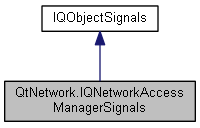|
Qyoto
4.0.5
Qyoto is a C# language binding for Qt
|
|
Qyoto
4.0.5
Qyoto is a C# language binding for Qt
|


Public Member Functions | |
| void | ProxyAuthenticationRequired (QNetworkProxy proxy, QAuthenticator authenticator) |
| | |
| void | AuthenticationRequired (QNetworkReply reply, QAuthenticator authenticator) |
| | |
| void | Finished (QNetworkReply reply) |
| | |
| void | SslErrors (QNetworkReply reply, System.Collections.Generic.List< QSslError > errors) |
| | |
| void | NetworkSessionConnected () |
| void | NetworkAccessibleChanged (QNetworkAccessManager.NetworkAccessibility accessible) |
| | |
 Public Member Functions inherited from QtCore.IQObjectSignals Public Member Functions inherited from QtCore.IQObjectSignals | |
| void | Destroyed (QObject arg1) |
| void | Destroyed () |
| | |
| void QtNetwork.IQNetworkAccessManagerSignals.AuthenticationRequired | ( | QNetworkReply | reply, |
| QAuthenticator | authenticator | ||
| ) |
This signal is emitted whenever a final server requests authentication before it delivers the requested contents. The slot connected to this signal should fill the credentials for the contents (which can be determined by inspecting the reply object) in the authenticator object.
QNetworkAccessManager will cache the credentials internally and will send the same values if the server requires authentication again, without emitting the authenticationRequired() signal. If it rejects the credentials, this signal will be emitted again.
Note: It is not possible to use a QueuedConnection to connect to this signal, as the connection will fail if the authenticator has not been filled in with new information when the signal returns.
See also proxyAuthenticationRequired().
| void QtNetwork.IQNetworkAccessManagerSignals.Finished | ( | QNetworkReply | reply | ) |
This signal is emitted whenever a pending network reply is finished. The reply parameter will contain a pointer to the reply that has just finished. This signal is emitted in tandem with the QNetworkReply::finished() signal.
See QNetworkReply::finished() for information on the status that the object will be in.
Note: Do not delete the reply object in the slot connected to this signal. Use deleteLater().
See also QNetworkReply::finished() and QNetworkReply::error().
| void QtNetwork.IQNetworkAccessManagerSignals.NetworkAccessibleChanged | ( | QNetworkAccessManager.NetworkAccessibility | accessible | ) |
This signal is emitted when the value of the networkAccessible property changes. accessible is the new network accessibility.
| void QtNetwork.IQNetworkAccessManagerSignals.NetworkSessionConnected | ( | ) |
| void QtNetwork.IQNetworkAccessManagerSignals.ProxyAuthenticationRequired | ( | QNetworkProxy | proxy, |
| QAuthenticator | authenticator | ||
| ) |
This signal is emitted whenever a proxy requests authentication and QNetworkAccessManager cannot find a valid, cached credential. The slot connected to this signal should fill in the credentials for the proxy proxy in the authenticator object.
QNetworkAccessManager will cache the credentials internally. The next time the proxy requests authentication, QNetworkAccessManager will automatically send the same credential without emitting the proxyAuthenticationRequired signal again.
If the proxy rejects the credentials, QNetworkAccessManager will emit the signal again.
See also proxy(), setProxy(), and authenticationRequired().
| void QtNetwork.IQNetworkAccessManagerSignals.SslErrors | ( | QNetworkReply | reply, |
| System.Collections.Generic.List< QSslError > | errors | ||
| ) |
This signal is emitted if the SSL/TLS session encountered errors during the set up, including certificate verification errors. The errors parameter contains the list of errors and reply is the QNetworkReply that is encountering these errors.
To indicate that the errors are not fatal and that the connection should proceed, the QNetworkReply::ignoreSslErrors() function should be called from the slot connected to this signal. If it is not called, the SSL session will be torn down before any data is exchanged (including the URL).
This signal can be used to display an error message to the user indicating that security may be compromised and display the SSL settings (see sslConfiguration() to obtain it). If the user decides to proceed after analyzing the remote certificate, the slot should call ignoreSslErrors().
See also QSslSocket::sslErrors(), QNetworkReply::sslErrors(), QNetworkReply::sslConfiguration(), and QNetworkReply::ignoreSslErrors().